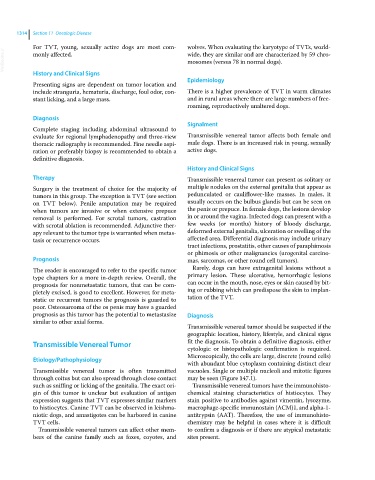Page 1376 - Clinical Small Animal Internal Medicine
P. 1376
1314 Section 11 Oncologic Disease
For TVT, young, sexually active dogs are most com wolves. When evaluating the karyotype of TVTs, world
VetBooks.ir monly affected. wide, they are similar and are characterized by 59 chro
mosomes (versus 78 in normal dogs).
History and Clinical Signs
Epidemiology
Presenting signs are dependent on tumor location and
include stranguria, hematuria, discharge, foul odor, con There is a higher prevalence of TVT in warm climates
stant licking, and a large mass. and in rural areas where there are large numbers of free‐
roaming, reproductively unaltered dogs.
Diagnosis
Signalment
Complete staging including abdominal ultrasound to
evaluate for regional lymphadenopathy and three‐view Transmissible venereal tumor affects both female and
thoracic radiography is recommended. Fine needle aspi male dogs. There is an increased risk in young, sexually
ration or preferably biopsy is recommended to obtain a active dogs.
definitive diagnosis.
History and Clinical Signs
Therapy Transmissible venereal tumor can present as solitary or
Surgery is the treatment of choice for the majority of multiple nodules on the external genitalia that appear as
tumors in this group. The exception is TVT (see section pedunculated or cauliflower‐like masses. In males, it
on TVT below). Penile amputation may be required usually occurs on the bulbus glandis but can be seen on
when tumors are invasive or when extensive prepuce the penis or prepuce. In female dogs, the lesions develop
removal is performed. For scrotal tumors, castration in or around the vagina. Infected dogs can present with a
with scrotal ablation is recommended. Adjunctive ther few weeks (or months) history of bloody discharge,
apy relevant to the tumor type is warranted when metas deformed external genitalia, ulceration or swelling of the
tasis or recurrence occurs. affected area. Differential diagnosis may include urinary
tract infections, prostatitis, other causes of paraphimosis
or phimosis or other malignancies (urogenital carcino
Prognosis mas, sarcomas, or other round cell tumors).
The reader is encouraged to refer to the specific tumor Rarely, dogs can have extragenital lesions without a
type chapters for a more in‐depth review. Overall, the primary lesion. These ulcerative, hemorrhagic lesions
prognosis for nonmetastatic tumors, that can be com can occur in the mouth, nose, eyes or skin caused by bit
pletely excised, is good to excellent. However, for meta ing or rubbing which can predispose the skin to implan
static or recurrent tumors the prognosis is guarded to tation of the TVT.
poor. Osteosarcoma of the os penis may have a guarded
prognosis as this tumor has the potential to metastasize Diagnosis
similar to other axial forms.
Transmissible venereal tumor should be suspected if the
geographic location, history, lifestyle, and clinical signs
Transmissible Venereal Tumor fit the diagnosis. To obtain a definitive diagnosis, either
cytologic or histopathologic confirmation is required.
Microscopically, the cells are large, discrete (round cells)
Etiology/Pathophysiology
with abundant blue cytoplasm containing distinct clear
Transmissible venereal tumor is often transmitted vacuoles. Single or multiple nucleoli and mitotic figures
through coitus but can also spread through close contact may be seen (Figure 147.1).
such as sniffing or licking of the genitalia. The exact ori Transmissible venereal tumors have the immunohisto
gin of this tumor is unclear but evaluation of antigen chemical staining characteristics of histiocytes. They
expression suggests that TVT expresses similar markers stain positive to antibodies against vimentin, lysozyme,
to histiocytes. Canine TVT can be observed in leishma macrophage‐specific immunostain (ACM)1, and alpha‐1‐
niotic dogs, and amastigotes can be harbored in canine antitrypsin (AAT). Therefore, the use of immunohisto
TVT cells. chemistry may be helpful in cases where it is difficult
Transmissible venereal tumors can affect other mem to confirm a diagnosis or if there are atypical metastatic
bers of the canine family such as foxes, coyotes, and sites present.

